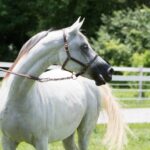Breed History
Chagaras are a unique dog breed, unfamiliar to many people. Chagaras originate from Cuba, where they were bred as farm and hunting dogs. Their lineage stems from the Cuban Bloodhound, which was brought to the island by Spanish conquerors in the 15th and 16th centuries. Over the next few hundred years, these hounds mixed with other breeds, creating the modern Chagara.
The Chagara became an essential part of Cuban rural life, valued for their ability to track and tree prey during hunts. They were also prized as watchdogs and companions.
After the Cuban Revolution in 1959, many wealthy Cubans fled to America bringing their Chagaras. It helped establish and promote the breed in the US. While still uncommon, Chagaras have a devoted following of owners and breeders today.
Characteristics and Temperament
Chagaras have a distinctive appearance setting them apart from other hounds. Chagaras are sturdily built yet remarkably athletic with flexible, agile bodies. Their long legs, arched neck, and narrow waist give them a regal look and movement.
Chagaras are highly intelligent, loyal, and people-oriented dogs. It means they don’t do well when left alone for long periods. Chagaras thrive on constant human companionship.
Despite their affection for family, Chagaras can be initially standoffish with strangers. Chagaras may develop nuisance behaviors such as excessive barking, digging, or chewing without proper outlets. Providing interactive play, long walks, running beside a bicycle, or other vigorous activities helps them channel their high drive.
Along with physical exercise, Chagaras need substantial mental stimulation. They excel at canine sports like agility, tracking, and obedience trials, which challenge their body and mind. Even just learning new commands and tricks helps satisfy their bright intellect.
Grooming and Care
Thanks to their short, close coats Chagaras are easy-care dogs for grooming. Occasional brushing using a hound glove or rubber brush removes dead hair and distributes skin oils. They shed moderately, but regular brushing can minimize loose fur around the home.
Only occasional bathing is needed since Chagaras rarely have a noticeable doggy odor. Along with physical exercise, providing interactive play, training activities, puzzle toys, and similar mental stimulation is crucial for a well-adjusted Chagara. Sign them up for canine sports or take tracking classes to give their agile mind an engaging job.
Without enough activity, Chagaras are prone to nuisance behaviors like escape attempts, barking, digging, and chewing. Make sure to meet their high daily exercise quotas.
As people-focused dogs, Chagaras crave companionship and do not thrive when left home alone for over 4 to 6 hours daily. They may suffer separation anxiety if isolated for long periods. Consider doggy daycare or a mid-day dog walker if unable to provide regular human interaction.
Chagara Health & Nutrition
Chagaras are healthy, hardy dogs with a 12 to 14-year life span without genetic issues, which affects the breed. However, responsible Chagara breeders still screen their breeding dogs for conditions like hip dysplasia and eye anomalies. Chagaras can suffer from gastric torsion (bloat), having deep-chested breeds, which can be fatal without emergency treatment.
A high-quality commercial or home-prepared diet is proper for medium to large-breed dogs and ensures good health. Dividing daily food intake into two or three smaller meals can prevent bloat risk. Always provide access to fresh, clean water.
Chagara ownership
Chagaras can make endearing family pets – though not ideal for families with small children due to their large size. They especially shine as companions for active individuals and couples who can meet their substantial daily exercise quotas. This breed needs a home where someone is around most of the time to provide companionship.Prospective owners should be aware that Chagaras tend to be independent thinkers with a stubborn streak at times
Along with advanced obedience work, Chagaras excels at canine sports like agility, tracking, barn hunts, and more. Signing up for regular classes provides them with fun activities plus critical mental stimulation.
While their short coat means little grooming, Chagaras do shed moderately year-round. Those with dog allergies may react to high household dander levels. Also, be prepared to vacuum up stray hairs regularly.
When raised alongside other pets, most Chagaras accept living in multi-pet homes. Supervise closely with smaller animals just to be safe. They may view outdoor cats and other small critters as fair game.
Conclusion
The unique Chagara may still fly under the radar for some but these Cuban hounds have much to offer the right owner. With their athleticism, intelligence, strong work ethic, and loving temperament they make outstanding canine companions. Chagaras do need plenty of activity, attention, socialization, and training – especially when young – but reward their people with complete devotion. If prepared to provide the high level of physical and mental stimulation they require, the loyal Chagara will eagerly join your days…and your heart.
FAQs
Q: What types of climates do Chagaras do well in?
A: Chagaras are quite adaptable and can thrive in most climates. They do fine in warm weather but their short coats also let them tolerate cold conditions well too. These dogs are athletic enough to exercise even in snow. Just avoid keeping them outside for extended frozen periods.
Q: How difficult is it to train a Chagara?
A: Thanks to their high intelligence and desire to work, Chagaras tend to be fairly easy to train using positive reinforcement methods. Start socialization and obedience foundation work early and be firm, fair, and consistent when teaching commands. Their independent nature means training requires dedication. Well-trained Chagaras have an enthusiastic work ethic.
Q: Do Chagaras get separation anxiety?
A: More so than many hound breeds, the people-oriented Chagara often suffers separation distress when isolated for too long away from family. How severe this tends to manifest varies from dog to dog but symptoms like destructive chewing, housetraining lapses, pacing, barking, and depression may happen.
Q: How often should I have my Chagara’s health screened?
A: Attending an initial veterinary exam shortly after acquiring your Chagara serves to establish health baselines. After puppy and senior vaccines/tests, and annual physical checkups from age 1 to senior years let your vet monitor for potential concerns like dental disease, osteoarthritis, cardiac changes, and so forth.






